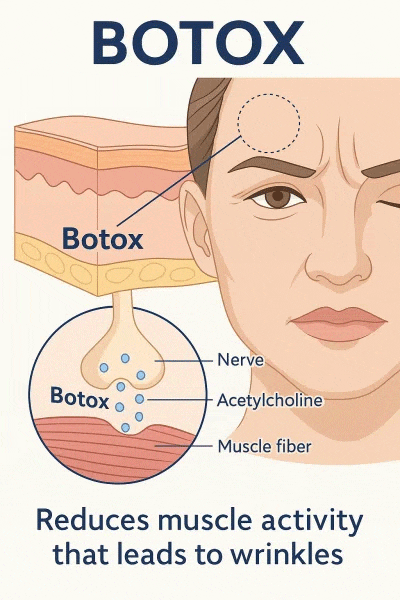Botox Edmonton: Smooth Wrinkles, Refresh Your Look
Looking to refresh your appearance and smooth away fine lines and wrinkles? At Albany Cosmetic and Laser Centre, our expert-administered Botox treatments help you achieve natural-looking, youthful results. Under the supervision of Dr. Salem Tomi, M.D. and Dr. Kamal Alhallak, Ph.D., we provide safe, customized Botox injections tailored precisely to your cosmetic goals.
Botox Treatment Summary

Treatment Cost
Procedure Duration
Results Longevity
Discomfort Level
How Botox Works Beneath the Skin
Botox, or Botulinum toxin type A, temporarily relaxes specific facial muscles responsible for expression lines. This effectively reduces dynamic wrinkles—such as frown lines, forehead creases, and crow’s feet—resulting in smoother, more youthful skin. By gently limiting muscle movement, Botox not only smooths existing wrinkles but also helps prevent new ones from forming over time.
Benefits of Choosing Botox
- Reduces forehead lines and crow’s feet
- Minimally invasive, with no downtime
- Quick, virtually painless procedure
- Natural, subtle results
- Results lasting 3-6 months
Understanding Wrinkle and How Botox Can Help

Wrinkles develop naturally as part of the aging process due to several factors, including the gradual reduction in collagen and elastin production, repetitive facial expressions, sun exposure, and lifestyle habits. Over time, these elements lead to decreased skin elasticity and firmness, creating fine lines and deeper wrinkles. Botox treatments at Albany Cosmetic and Laser Centre specifically target wrinkles caused by muscle contractions, helping to restore smoother, younger-looking skin.
Preparation and Aftercare Timeline
3 to 7 Days Before: Preparation
- Avoid blood-thinning medications (like aspirin, ibuprofen) to reduce bruising.
- Refrain from alcohol consumption at least 24 hours before treatment.
- Stay hydrated and ensure your skin is well-moisturized.
Treatment Day: What to Expect
- The procedure takes 10–20 minutes with minimal discomfort.
- You may experience mild redness or swelling, which resolves within hours.
- Avoid rubbing the area or lying down flat for at least four hours. Skip strenuous exercise and saunas for 24 hours.
1 to 7 Days After: Immediate Aftercare
- Stay upright for 4 hours after treatment to prevent Botox from migrating.
- Skip strenuous exercise, saunas, and alcohol for 24 hours.
- Apply ice gently if needed, stay hydrated, and avoid alcohol for 24 hours.
7 to 14 Days: Full Results Appear
- Full Botox results become noticeable, showing smoother skin.
- Maintain skincare routines, use sunscreen daily.
- Resume normal activities fully—enjoy your refreshed look!
3 to 6 months: Long term maintenance
- Results last 3-4 months; book your follow-up treatments regularly.
- Consider complementary treatments (Fillers, HydraFacial) for maximum glow.
- Maintain healthy skin routines for prolonged benefits.